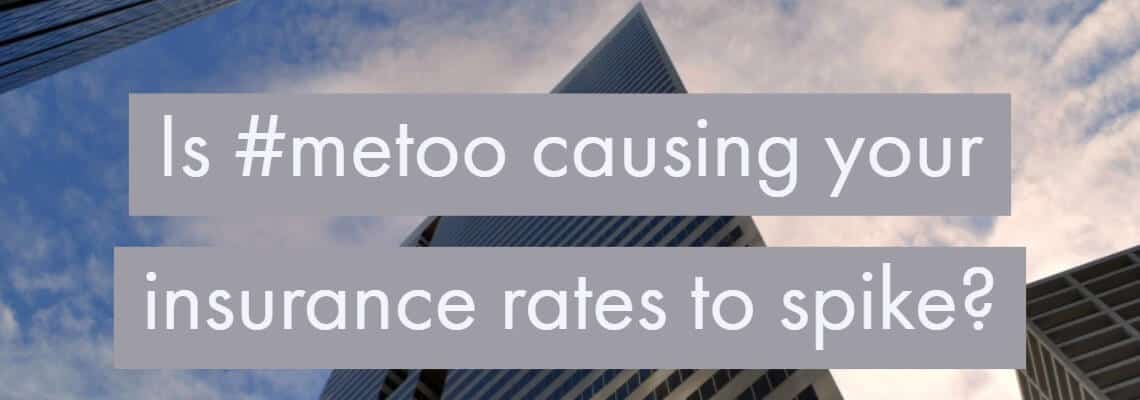Larry Nassar. UBS Financial Services. Bill Cosby. Anthony Weiner. Brock Turner. Harvey Weinstein. Rohit Varma. Justin Caldbeck. Mike Cagney.
2017 saw an increase in the number of sexual harassment and assault allegations being reported to HR departments and in the media. What many see as progress, has had some unintended consequences for businesses large and small.
As more and more high-powered men were accused, charged and indicted, their companies used employment practices liability (EPL) coverage to pay for their own defense. This seems like a common sense move. You bought the policy to cover any number of employee-related claims against your business, like discrimination, wrongful termination and, yes, sexual harassment. You used the coverage to pay for your defense.
In any normal circumstance, there would be nothing out of the norm. However, what we’ve seen since 2016 hasn’t been normal. Between the intense media coverage and social movements like #metoo and Time’s Up, women have been empowered to speak up about the discrimination and harassment they face in the workplace. And they’re being heard.
Not only have the number of claims increased, but companies are having to pay more for settlements and defense costs than ever before. It’s an unfortunately natural byproduct of the industry that leads insurance companies to increase their rates, especially on those in industries like technology, entertainment, law and medicine that are more susceptible to this kind of abuse.
The Reaction
Many businesses don’t know how to address this issue because they never have never been put in the position to deal with it head on, so it comes as no surprise that many are doing nothing. They’re continuing to function under the same modus operandi as before these scandals with their fingers crossed that it doesn’t impact their business.
Others are evaluating their EPL coverage for limits and other coverage options available. However, only 41 percent of businesses with more than 1,000 employees had this type of coverage to begin with, so the majority of businesses are looking into EPL coverage, even as the rates rise.
The most proactive businesses are creating two-fold strategies to address the increase of harassment and assault claims. Like many other businesses, they are evaluating their EPL coverage to make sure it still meets their needs. But they are also creating and implementing additional training programs or internal harassment policies to try and prevent this type of abuse before it has the opportunity to occur.
Shift your focus from protecting to preventing
Workplace harassment and sexual assault are not new phenomena. And so much of how we react to and treat victims of harassment and assault has remained the same for decades. We’ve always seen it as an inevitability when people work in mixed company. So much so that some employers worry less about preventing harassment and assault in their offices and more about protecting their own assets. Others try to protect victims. The vast majority just try to protect their business.
While it’s understandable to want to protect your own interests as a business owner, maintaining reactionary policies when it comes to harassment and assault is not enough. It’s time to start creating preventative policies that protect your assets, your employees and your business. All it requires is a shift in thinking.
Update Your Policies
When was the last time you reviewed your employee handbook or other corporate policies? A year ago? More than that? The first step to moving towards a preventative model requires that you first audit your current process for managing allegations. Then ensure there are checks in place to enforce the policies you create and consequences for breaking them. Words alone are worthless. Your policies are only as good as the managers who enforce them.
Training and Reinforcement Programs
While it is good practice to host harassment trainings, some carriers now require companies to create and execute these trainings as a part of their EPL coverage. You don’t even need to be in the same room with your employees to host harassment trainings. There are a significant number of online resources that offer online trainings at a lower cost than in-person alternatives. Whether you choose online or in-person trainings, though, depends on your employees and their receptiveness to the material.
Review Your Event Planning Procedure
Corporate events and out-of-town travel provide unique opportunities for increased assault and harassment allegations. Conventions, exhibitions and other celebratory events generally come equipped with copious amounts of alcohol, which leads to lowered inhibitions and the potential for harassment. While this isn’t always true, it is a factor that should be taken into consideration when creating and reviewing your event planning procedures. If you don’t have a way of preventing or mitigating the risks involved with these events in your current policies, it’s time to rewrite your policies.
Where to Go From Here
Sexual assault and harassment claims won’t disappear overnight. To truly protect your company from these claims you need to be proactive in preventing them from being a possibility. Rewrite your policies and implement trainings or reinforcement campaigns. If you don’t know how to go about mitigating the risks in your business, hire an objective third-party to guide you. It’s imperative that you get in front of these scandals instead of hiding from them.


